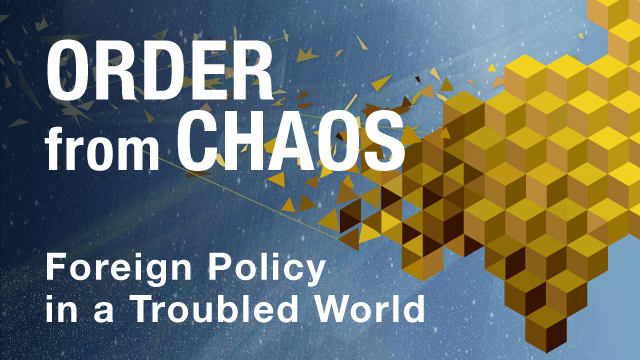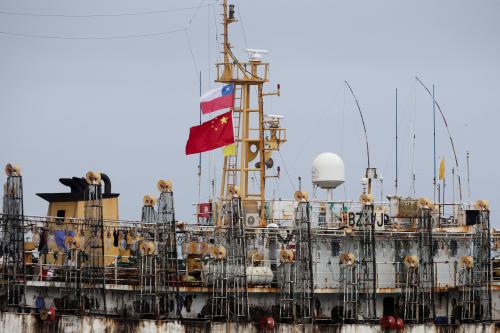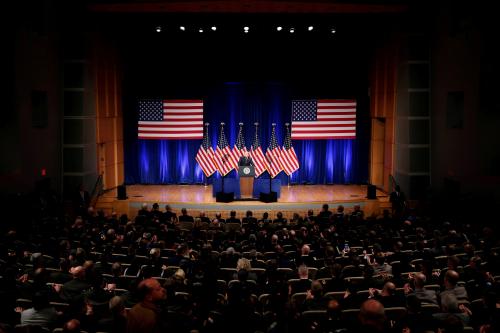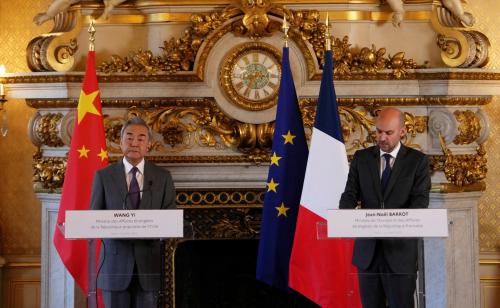Mira Rapp-Hooper joined the Brookings Institution in April 2025 as a visiting fellow in the Center for Asia Policy Studies (CAPS) after most recently serving as special assistant to the president and senior director for East Asia and Oceania at the National Security Council (NSC). Before that, she served as the NSC’s director of Indo-Pacific Affairs. She previously held senior fellowships at the Center for a New American Security and the Center for Strategic and International Studies. She is the author of two books.
In the following interview, she discusses the Biden administration’s Indo-Pacific strategy and where the reordering of Asia is headed with Mireya Solís, director of CAPS and the Philip Knight Chair in Japan studies.
Mireya Solís:
Mira, welcome back to Brookings. Can you share with us your career path and how you got to where you are?
Mira Rapp-Hooper:
I was early to national security, but my path to becoming an expert on national security and strategy in Asia has been a winding one. I became interested in world history and geopolitics when I was in high school, and I knew that national security would be my career in some form beginning in 2001. I was a senior in high school just a few blocks north of the World Trade Center on September 11, and the experience of seeing my fellow New Yorkers trapped in a war zone and running from the collapsing towers was an early inflection point for me.
But my career hasn’t been remotely linear. I studied Cold War history as an undergraduate and entered a doctoral program in international relations knowing that I might not choose to become a tenure-track academic, but very much wanting to be able to think, research, and write like a political scientist. When I arrived at Columbia, it was to study nuclear weapons and nuclear strategy with some of the leading international relations (IR) scholars of the age (Robert Jervis, Ken Waltz), but while I was writing my dissertation on extended deterrence, I fell in love with Asia. Much of academic IR theory is built on 20th-century European cases, but as I started to learn more about the Indo-Pacific, it was clear that all of the most interesting geopolitical dynamics were now happening there. So, I began traveling to Japan and the Republic of Korea (ROK) for research and studying and teaching Chinese foreign policy. By the time I was ready to defend my dissertation, I wanted to remain focused on the region.
I had decided that I wanted to begin my career as a researcher at think tanks, and hoped to serve in government at some point, knowing that such an opportunity is never guaranteed. I was fortunate that Mike Green offered me my first post-Ph.D. job at the Center for Strategic and International Studies; I was also an Asia scholar at the Center for a New American Security and the Council on Foreign Relations. My opportunity to serve on a presidential transition team and then in government came with President Joe Biden. All of a sudden, I had a chance to help put into practice some of the big ideas that I had been refining for years. And serving at the NSC, moreover, is the stuff of a security studies nerd’s dreams.
Mireya Solís:
Looking back, what were the biggest strengths of the Biden administration’s Indo-Pacific strategy? What were some of the hardest challenges or unrealized objectives?
Mira Rapp-Hooper:
I’ll name two huge strengths of the Biden administration’s Indo-Pacific Strategy (IPS). First, it correctly diagnosed that if the United States fashioned an approach that appealed to a wide range of allies and partners, it could shift the balance of power away from the People’s Republic of China (PRC) and back in our collective favor. We crafted the IPS as an affirmative, forward-looking strategy that clearly grappled with the challenge posed by the PRC without framing it as a counter-China strategy. We made the calculation that by standing for a region that was free, open, connected, secure, and resilient, we could win a lot more support than we would if we framed our interests in terms of who or what we were against. And that paid off. One of the most memorable initiatives I had the privilege of working on was our comprehensive strategic partnership with Vietnam—an unprecedented double-upgrade in our relationship that was possible in part because Vietnam identified with the way we’d framed the IPS.
The second, related strength of the IPS was that we implemented it as a cohesive strategy across the administration. It is common for administrations to release pithy strategies, but it’s relatively rare that the document actually guides interagency coordination, diplomatic initiatives, and overseas investments to the extent ours did. Because the IPS placed so much weight on allies and partners, we wound up outperforming our expectations. Many allies were also willing to step up and do a lot more to contribute to the region than we’d imagined when we were drafting the document (think: former Japanese Prime Minister Fumio Kishida, who committed to boosting Japan’s defense spending and carved out a much more proactive role for his country on the global stage). That enthusiasm from the region contributed to a positive cycle in which we were able to continue moving through the goals we’d laid out in the strategy and setting our sights ever higher.
There were plenty of challenges, of course. The political consensus in the Democratic and Republican parties has shifted to be much more skeptical toward trade, which is both a political reality and tough when you’re on the Asia beat. Many of our partners and allies understandably held out hope that the United States would find a way to return to the Comprehensive and Progressive Agreement for Trans-Pacific Partnership, which was really never in the offing. That was challenging and meant that we were always met with some skepticism on economic issues, including on the Indo-Pacific Economic Framework, which made some real contributions, such as the supply chain pillar. It was always clear that our partners wanted more. Over the course of the Biden administration, we learned a lot about how to up our game in providing economic alternatives to the PRC, particularly with big infrastructure initiatives and work to diversify critical supply chains. But we were really just hitting our stride in some of that work in years three and four—think, for example, our work to invest in Vietnam’s tech sector or the Luzon Economic Corridor project in the Philippines. We also got much better at pursuing strategic projects alongside Indo-Pacific partners, such as submarine cables. With more time, I think we would have been doing work like this across the region.
There are also some perennial challenges that come with working on the theater that everyone agrees is central to the United States’ long-term geopolitical interests, including that crises elsewhere can easily distract from those objectives. We were lucky that President Biden and National Security Advisor Jake Sullivan were deeply committed to Asia and continued to drive major initiatives and convenings even as the war in Ukraine raged and after Hamas’ attack against Israel on October 7, 2023. But even with that leader-level focus and intention, we faced tradeoffs. Indo-Pacific budgets held steady or increased modestly year over year, but I would have liked to see them grow even more.
Mireya Solís:
What explains the rapid proliferation of minilaterals in the Indo-Pacific? Absent treaty security commitments, what are the key ingredients for effective minilateral cooperation?
Mira Rapp-Hooper:
A great question—worthy of a whole book! Plenty of scholarship explains why there was no multilateral alliance system unfurled across East Asia in the early Cold War period (Victor Cha’s “Powerplay” article is my favorite). To summarize, American allies there faced different threats, had different objectives, and in some cases, did not particularly trust one another enough to warrant a more unified grouping at the time. And while important regional institutions like the Association for Southeast Asian Nations and the Asia-Pacific Economic Cooperation forum stood up later in the 20th century, the region was still relatively light on architecture given its geographic size, economic might, and diversity of participants. But the proximate cause for the proliferation of minilaterals was the PRC’s much more aggressive foreign policy turn, and the growing nuclear and missile threat from the Democratic People’s Republic of Korea (DPRK). You do not get a vibrant, thriving Quad1 prepared to work across the region with a common purpose without China’s attack on India in the Himalayas in 2020; likewise, ROK-Japan rapprochement does not happen without a growing DPRK nuclear program and improved delivery capabilities, with a healthy helping of China anxiety there too.
But while it is the case that shared challenges can pull partners together, shared objectives and a common agenda are needed to keep them there, and that will always be true. We found that the best way to craft common agendas was to identify problems that each partner needed to solve anyway, and then to identify ways that they could contribute to the solution that would work for their system. Just as importantly, for minilaterals to be welcomed by their neighbors, they need to produce something that we couldn’t have offered otherwise—something that is superior to the PRC’s offer.
My favorite example is probably the Indo-Pacific Partnership for Maritime Domain Awareness (MDA), the maritime domain awareness platform we offered through the Quad. It’s a great example of how a federated partnership structure can tackle a region-wide problem, in this case, dark shipping. The United States pulled together the funding to bring this new capability to partners with whom it already had MDA relationships in Southeast Asia; India is bringing it to the Indian Ocean regional fusion center; Australia has worked with the Forum Fisheries Agency to bring the capability to the Pacific Islands, with training support from Japan. This particular project has taken an incredible amount of work across the U.S. and all four Quad governments. But to my mind, practical, positive cooperation that puts a better offer on the table is minilateralism done right.
Mireya Solís:
At a moment of geopolitical fluidity, how do you foresee the reordering of Asia?
Mira Rapp-Hooper:
Fluidity is generous! To my mind, we are at a moment of consequential geopolitical flux, as we complete the transition out of the post-Cold War world into something entirely distinct. It is very much a reordering moment, of the kind that happens only a few times per century at most. This transition started over a decade ago with the global financial crisis of 2007-2009, America’s overextension in Iraq and Afghanistan, and China’s undeniable rise. But it will probably take a few more years until we know exactly what it looks like, and of course, the precise nature of the U.S. role is uncertain. The last time this really happened was in the aftermath of the collapse of the Soviet Union, but that was a transformation of tremendous privilege for the United States. This one is much more challenging.
When it comes to the Indo-Pacific, however, a few things are clear. First, the strong and assertive China we have all become acquainted with isn’t going anywhere, even if Beijing adjusts the elements of its strategy over time. Second, the Biden administration didn’t just succeed at bringing together regional partners but also encouraged closer ties among them. Japan, Australia, India, the ROK, the Philippines, and Vietnam have deepened their ties in remarkable ways, and those aren’t going anywhere either. Third, and also a conscious effort, Europe now understands and sees a stake in the Indo-Pacific in ways that it simply did not before. But for allies and partners inside and outside the region, their calculations about the role that the United States intends to play vis-à-vis China and in the region broadly will continue to be determinative in their own strategies. The Trump administration has an opportunity to build on an unprecedented degree of strategic alignment to continue to shape the region in directions advantageous to the United States and our friends, and to do otherwise will only be to China’s advantage. An unchecked PRC will seek to dominate the South China Sea, put tremendous pressure on Taiwan, and may gain technological advantages in areas from semiconductors to artificial intelligence that imperil long-term U.S. interests. Of course, where tariff policy lands will also determine a lot about whether the Trump administration can sustain this strategic alignment. Every administration must craft its own strategy for the region, but any strategy that protects long-term U.S. interests requires allies and partners to succeed.
-
Footnotes
- The multilateral grouping of India, Japan, Australia, and the United States.
The Brookings Institution is committed to quality, independence, and impact.
We are supported by a diverse array of funders. In line with our values and policies, each Brookings publication represents the sole views of its author(s).









Commentary
Meet Mira Rapp-Hooper, Indo-Pacific security expert
May 28, 2025